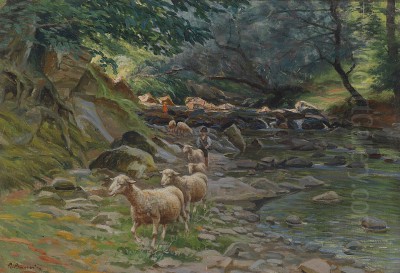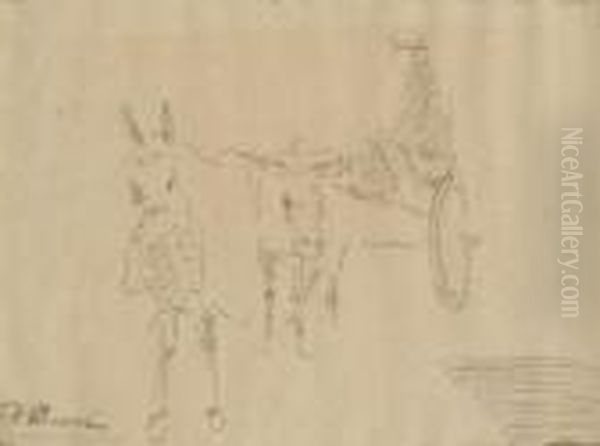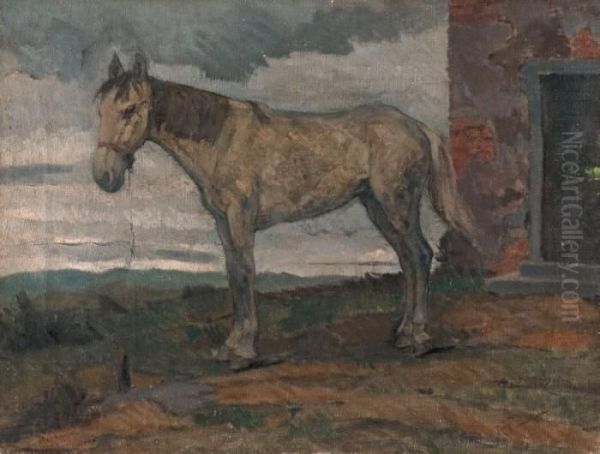
Ruggero Panerai (1862-1923) stands as a significant figure in Italian art during the late nineteenth and early twentieth centuries. Born in the heart of Tuscany, Florence, and passing away in Paris, Panerai's life and work bridge the vibrant legacy of the Macchiaioli movement with the evolving artistic currents of his time. As both a painter and illustrator, he captured the essence of Tuscan landscapes, the dynamism of military life, the elegance of horses, and the intimate moments of everyday existence, leaving behind a body of work characterized by its freshness, vitality, and connection to the natural world.
Florentine Roots and Academic Training
Born on March 19, 1862, Ruggero Panerai grew up immersed in the rich artistic atmosphere of Florence. This city, a cradle of the Renaissance, continued to be a vital center for art in the 19th century. Panerai's formal artistic education took place at the prestigious Accademia di Belle Arti di Firenze (Florence Academy of Fine Arts) between 1877 and 1881. This period was crucial in shaping his technical skills and artistic vision.
During his time at the Academy, Panerai had the distinct privilege of studying under Giovanni Fattori (1825-1908), one of the leading figures of the Macchiaioli group. Fattori was renowned for his powerful depictions of military scenes, rural labor, and the distinctive landscapes of the Tuscan Maremma. His emphasis on capturing reality through bold contrasts of light and shadow, using patches (macchie) of color, profoundly influenced a generation of artists, including Panerai.
The Macchiaioli movement, often considered the Italian precursor or parallel to French Impressionism, sought to break free from academic conventions and paint contemporary life and landscapes with honesty and immediacy. Artists like Telemaco Signorini, Silvestro Lega, and Vincenzo Cabianca, alongside Fattori, pioneered this approach, often working outdoors (en plein air) to capture the fleeting effects of light. Panerai absorbed these principles, particularly Fattori's focus on naturalism and his dedication to depicting the Tuscan environment.
Development of an Artistic Style

Panerai emerged from his training as a skilled naturalist painter. His early works often reflected the direct influence of Fattori, focusing on themes familiar to his master: military subjects, scenes featuring horses, and landscapes, especially those of the Maremma region. This coastal area of southern Tuscany, with its wild beauty, distinctive light, and traditional way of life (often involving cattle and horse breeding, known as butteri), was a recurring motif for Fattori and subsequently for Panerai.
While clearly indebted to Fattori, sources suggest Panerai developed his own distinct interpretation. Some analyses describe his early work, compared to Fattori's, as perhaps somewhat simplified yet possessing a unique "complexity and syntax." He was adept at capturing the essence of a scene with a certain lightness and vivacity. His style is often described as having qualities reminiscent of Impressionism – characterized by a sketch-like feel, freshness, and a lively application of paint.
Further influences shaped his evolving style. The provided information mentions an influence from "Guido Carofiglio," whose approach reportedly contributed to the sketch-like, light, and fresh qualities in Panerai's work. This emphasis on spontaneity and capturing immediate sensations aligns him with the broader trends of European painting moving towards modernism, although he remained deeply rooted in the Tuscan realist tradition.
Dominant Themes and Subjects
Panerai's oeuvre is diverse, yet certain themes recur and define his artistic identity. His time in military service between 1877 and 1881 seems to have provided direct inspiration for his military paintings, a genre popular in post-Risorgimento Italy and one in which his teacher, Fattori, excelled. These works often depicted soldiers, cavalry maneuvers, and the daily life of the barracks.
Animal painting, particularly the depiction of horses, became one of Panerai's hallmarks. He possessed a remarkable ability to capture the anatomy, movement, and spirit of these animals, whether they were working farm horses, elegant cavalry mounts, or wild horses roaming the Maremma. His paintings often convey a deep understanding and appreciation for the horse, portraying its strength, grace, and vital energy. This focus connects him not only to Fattori but also to a wider European tradition of animal painting, exemplified by artists like the French painter Rosa Bonheur.
Landscape painting remained a constant throughout his career, with the Tuscan countryside, especially the Maremma, providing endless inspiration. He captured the unique light, atmosphere, and rustic charm of these regions, continuing the Macchiaioli tradition of celebrating the local environment. His landscapes are imbued with a sense of place and a naturalist's eye for detail, rendered with his characteristic fresh brushwork.

From around 1886, Panerai increasingly turned his attention towards genre painting. These works depicted scenes from contemporary Florentine life or historical vignettes, often featuring figures in 18th-century costume. This shift allowed him to explore narrative, human interaction, and the details of social settings, moving beyond pure landscape or animal studies. These genre scenes offer valuable glimpses into the society and aesthetics of his time, perhaps echoing the interest in modern life seen in the work of Italian artists based in Paris, such as Giuseppe De Nittis or Federico Zandomeneghi.
Notable Works and Exhibitions
Panerai was an active participant in the Italian art scene, exhibiting his work regularly and gaining recognition. Several specific paintings stand out as representative of his talent and achievements.
Cavallo malato (Sick Horse): This work earned him significant recognition early in his career, winning the Fumagalli prize (potentially the "Fumigationi" prize mentioned in one source) in Milan in 1886. This award highlighted his skill in animal depiction and his ability to convey emotion and narrative.
Guado (The Ford): Exhibited in Venice in 1887, this painting likely showcased his ability to integrate figures or animals within a landscape setting, a common theme for naturalist painters.
Mazzeppa: This painting, based on the dramatic poem by Lord Byron about a Polish nobleman tied naked to a wild horse, was exhibited in Bologna in 1888. Its success was pivotal, reportedly leading to Panerai being offered a position as a lecturer at a local art academy in Florence. The subject matter reflects the Romantic influences still prevalent in the late 19th century.
Una stalla di muche (A Cow Shed): Shown at the Promotrice Fiorentina exhibition in 1890, this title suggests a focus on rural life and animal husbandry, themes central to the Maremma tradition.
Cavalli (Horses): Perhaps one of his most celebrated works, this painting depicting the elegant forms of wild horses was exhibited at the Paris Exposition Universelle (World's Fair) in 1900, bringing his work to a major international audience. It is now housed in the prestigious Galleria dell'Accademia in Florence, home to Michelangelo's David, signifying its importance in the context of Florentine art.
Un’altra sera (Another Evening / One Evening): Exhibited in Rome in 1892, this title hints at a genre scene or a landscape imbued with the atmosphere of twilight.
Contadina (Peasant Woman): A small oil painting dated 1885, noted for its specific provenance details. This work exemplifies his engagement with depicting figures from rural life.
Donna al Telaio (Woman at the Loom): This title points to a genre scene focusing on domestic labor, a theme explored by various realist painters of the period.
Danza (Dance): Suggests a scene of movement and social interaction, possibly part of his genre painting phase.
Cavalli in sosta (Resting Horses) and Cavallo bianco (White Horse): These works have appeared on the art market, with auction estimates indicating continued collector interest in his equine subjects.
His participation in exhibitions in major Italian cities like Milan, Venice, Bologna, Rome, and Florence, as well as internationally in Paris, demonstrates his active career and the esteem in which his work was held during his lifetime.
Artistic Context and Connections
Ruggero Panerai occupies an interesting position within the trajectory of Italian art. As a student of Fattori, he is undeniably linked to the Macchiaioli, often considered part of the "second generation" or a Post-Macchiaioli artist who carried forward the movement's core tenets of realism and painting from life, particularly the focus on Tuscany. His work embodies the continuation of this strong regional tradition.
While the provided sources state there is no direct record of his specific interactions with many other painters beyond his teacher Fattori, his work exists within a rich artistic milieu. He was a contemporary of other artists who emerged from Fattori's circle, such as Plinio Nomellini and Oscar Ghiglia, who would take Tuscan painting in different directions, often towards Symbolism or more modern idioms.
His naturalism and focus on rural and military themes align him with the broader current of Verismo (Realism) prevalent in Italian art and literature in the late 19th century. This movement sought to depict the realities of everyday life, often focusing on regional character and social conditions. Artists like Francesco Paolo Michetti, known for his vibrant depictions of life in the Abruzzo region, or Giuseppe Pellizza da Volpedo, famous for his socially conscious works like The Fourth Estate, represent different facets of this realist impulse.
Panerai's lighter palette and fresh, sketch-like technique in some works show an awareness of broader European trends, even if he wasn't a direct participant in French Impressionism like his compatriots Boldini or De Nittis. His dedication to capturing light and atmosphere connects him spiritually to the concerns of Impressionism, filtered through a distinctly Italian sensibility. He worked during a period of great artistic ferment in Italy, which also saw the rise of Divisionism, championed by artists like Giovanni Segantini and Gaetano Previati, who explored light and color through a more scientific and symbolic lens. Panerai, however, remained largely faithful to the naturalist path forged by Fattori.
Legacy and Market Presence
Ruggero Panerai passed away in Paris on October 27, 1923. He left behind a legacy as a skilled and sensitive painter deeply connected to his Tuscan roots. His work is valued for its technical proficiency, particularly in the depiction of horses, and for its evocative portrayal of the landscapes and life of late 19th and early 20th century Italy.
His paintings continue to be appreciated by collectors and institutions. The presence of his work, like Cavalli, in major museums such as the Galleria dell'Accademia in Florence ensures his contribution is remembered within the narrative of Italian art history. The appearance of his works at auction, such as Cavalli in sosta and Cavallo bianco, indicates a sustained market interest, particularly for his characteristic equine subjects and landscapes.
While perhaps not as revolutionary as the first-generation Macchiaioli or as internationally famous as some of his Italian contemporaries who worked abroad, Panerai played a vital role in carrying the torch of Tuscan naturalism into the early 20th century. His paintings offer a window onto a specific time and place, rendered with honesty, skill, and an evident love for his subjects.
Conclusion
Ruggero Panerai was a quintessential Florentine artist of his era. Steeped in the traditions of the Macchiaioli through his training with Giovanni Fattori, he developed a personal style characterized by lively brushwork, a keen eye for observation, and a deep connection to the Tuscan landscape and its inhabitants, both human and animal. From dynamic military scenes and masterful equine portraits to intimate genre paintings and evocative landscapes of the Maremma, his work captures the spirit of late 19th and early 20th century Italy. As a painter, illustrator, and teacher, Panerai made a significant contribution to the rich artistic heritage of Tuscany, leaving behind works that continue to resonate with their freshness, vitality, and authentic portrayal of the world around him.